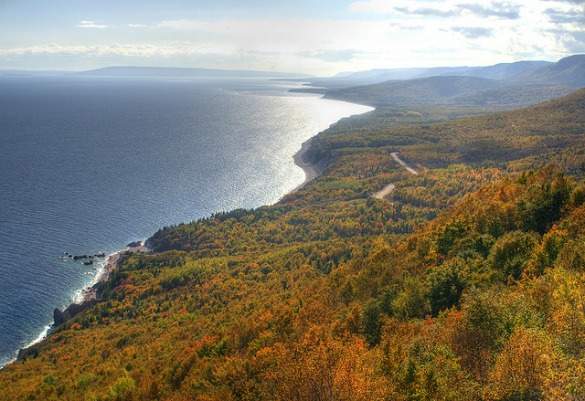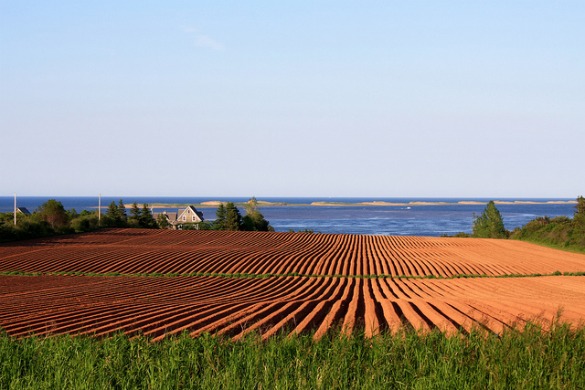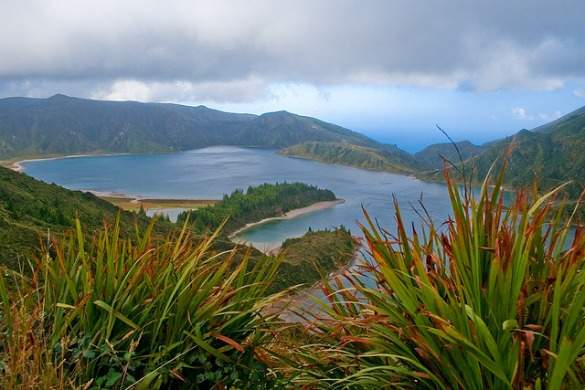What often comes to mind when people think of islands in the north Atlantic are visions of isolation and grey skies, rain, snow, ice, and the layers upon layers of clothes necessary to insulate oneself against the bone-chilling wind that blows through much of the region 3/4 of the year. It is true many parts of the north Atlantic can be a bit nippy. The ocean does freeze over, snow blankets much of the landscape, and things slow way, way down.
What those “from away” do not realize is that the very same elements that keep so many from visiting the islands are precisely what give them their strong sense of community, flourishing music and arts scenes, distinctive culinary traditions and powerful landscapes. Harsh winters mean more time for long conversations over hot drinks, a rich history of storytelling, lively nights of fiddle jams next to a fire, poetry readings, ice-skating on frozen rivers, ice-fishing with friends, and a commitment to community service. Harsh winters also give way to stunning displays of colourful wildflowers in spring and early summer, lush agricultural fields and plentiful harvests, fresh seafood, wave-swept beaches, and flaming autumn foliage.
If you are looking for an island getaway that will indulge all your senses and enfold you in closely-knit community and wild landscapes that you may find yourself returning to again and again, the following five island destinations may just be your home away from home:
Cape Breton
Cape Breton is a rugged island in Atlantic Canada characterized by steep, rocky shores and bare headlands, deep valleys, rolling farmland, wooded highlands, mountains and plateaus—all surrounded by the deep blue Atlantic Ocean. With five distinctive cultural communities (the Native Mi’kmaq, the French Acadians, the Scots, the English and the Irish), the island has a wide diversity of culinary, music, and craft traditions, which explains why Travel and Leisure World have ranked it as the number one island destination in North America.
To see the best that Cape Breton has to offer, drive, hike, bike or cross-country ski (in early spring) along the Cabot Trail and through Cape Breton Highlands National Park. To enjoy views of dramatic, rust-coloured cliffs tumbling down into the ocean, start at Cheticamp, an Acadian settlement on the island’s northwestern shore, known for its handicrafts and live Acadian fiddle tunes, and work your way south to Pleasant Bay, a picturesque fishing village offering whale-watching boat tours (Cabot Trail Whale Watching). There are plenty of B & Bs and campsites along the trail. Corney Brook campsite, just north of Cheticamp, has incredible coastline views.
A trip to Cape Breton would not be complete without visiting the vast Bras D’or saltwater lakes for a swim, or Eskasoni, the largest of the five Mi’kmaq reserves on the island. The Herring Choker Deli, north of the lakes in Nyanza is a great local joint to stop for a gourmet sandwich along the road. To escape the crowds, take highway 4, which winds along the south shore of the lakes, stopping to take in the views of the ocean from Battery Park. The eastern shore of Cape Breton also has unique wilderness areas and far fewer visitors. Spend an afternoon on Isle Madame – a wooded island of Acadian heritage with pristine beaches and quiet walking trails, or explore the island’s coastline by Kayak. Music enthusiasts should stop in Mabou for a hearty meal and an evening of live Celtic music and dancing at the Red Shoe Pub. The Inn at Glendyer is only five minutes away.
The easiest way to get to Cape Breton is by car via the Trans-Canada Highway at the Canso Causeway from mainland Nova Scotia. Visitors can also fly into Sydney. For more information, visit https://www.cbisland.com/.
Prince Edward Island
Prince Edward Island (PEI), located northwest of Cape Breton in the Gulf of Saint Lawrence, is Canada’s smallest province. Originally settled by the Mi’kmaq, who named it Epekwitk (meaning cradled on the waves), PEI’s land and seascapes have become world famous as a result of Lucy Maud Montgomery’s novel, Anne of Green Gables, which was set on the island. The rolling hills, small family farms, bright red, iron-rich soil, sandy beaches and dunes, salt water marshes, red sandstone cliffs, wind-swept headlands and lighthouses, colorful fishing harbors, and the striking contrast between the rusty soil, sharp green vegetation and deep blue of the Atlantic all make the island a very hard place to leave.
Charlottetown is the island’s capital, and is worth a full day’s visit. Start with a superb cup of European coffee and a freshly baked pastry at Leonhard’s, on University Avenue. Wander down Victoria Row, Queen Street, and along Peake’s Harbour to check out the local handicrafts and fine art. Take a stroll along the boardwalk for great views of the harbor, go on a tour of Founder’s Hall, and pamper yourself with a pricey but excellent meal sourced from local farms at Lot 30. In the evening, get tickets to see the Anne of Green Gables musical.
Cyclists can explore central PEI via the 167-mile long Confederation Trail, which stretches the length of the island. Rent a bike at Mac Queen’s Bike Shop, and swing by the lively Charlottetown Farmer’s Market to pick up food, and a cup of tea from Lady Baker’s Tea Trolley for the road. The Trailside Inn and Café in Mount Stewart is a perfect spot for an evening of live music and a nightcap after a day of cycling, or head west to explore the island’s red clay roads and Trout River, and enjoy a good night’s sleep (and panoramic vistas) at Caleb’s Outlook in New Glasgow. Spend a day walking the sandy beaches and marshland trails in the north shore’s National Park, followed by a lobster supper at Fisherman’s Wharf, or a bowl of seafood chowder with a view out over one of PEI’s rivers at the PEI Preserve Company. To explore the south shore, head to the fishing village of Victoria by the Sea, where you can taste locally made chocolates, swim in the (slightly) warmer water, watch a play at the local playhouse, and drive down the coast for supper at the Historic Maplethorpe in Bedeque.
PEI’s Charlottetown airport has direct flights to Montreal and Toronto. The island is connected to the mainland by the Confederation Bridge, and there are ferries to Cape Breton and mainland Nova Scotia. For more information, visit Tourism PEI’s website.
>> Read our PEI travel guide or search for hostels on Prince Edward Island
Îles de la Madeleine
Les Îles de la Madeleine, or Magdalen Islands, are an archipelago of twelve wind-swept islands located northeast of PEI in the Gulf of Saint Lawrence. Six of the islands are connected to each other via long, thin sand-spits. Officially part of the province of Quebéc, the islands are geographically closer to PEI, and the easiest and most popular route to reach them is by taking the five-hour CTMA ferry ride from PEI’s eastern port of Souris to Île du Cap-aux-Meules.
The Magdalen Islands have extensive (albeit rather windy) cycling routes and cliff-top hiking trails. They are also a superb place to kayak, wind and kite surf, snorkel and scuba dive, and explore sea caves. The Magdalene’s boast over 300 species of birds, and birding is the perfect way to fully explore the diversity of landscape spread across the islands. In the winter months, the archipelago offers cross-country skiing, snowshoeing, and seal watching.
The Magdalene Islands have a rich culinary tradition. After a long day of hiking along the western cliff top trail on Île du Cap-aux-Meules, enjoy the sunset with a cold pint of locally brewed beer at À l’abri de la Tempête, a scoop of chocolat noir épicé (chocolate with cinnamon) ice cream from Mer de Glace, or a delicious lobster-crab club sandwich at Chez Armand. Given that the main economic activity on the islands is fishing, they are a good place to enjoy fresh lobster, and shellfish. Pot-en-pot, a mixture of seafood baked in a pie crust, and loup-marin (seal) are local favorites.
There are many places to stay on the Magdalene Islands. If it is not too windy, camping is a great way to fully experience the archipelago. If you would rather sleep between four walls, Aux Vents des Îles on Cap-aux-Meules is a good bet, or if you want to splurge, make a reservation at the beautifully restored Domaine du Vieux Couvent. Hotel Havre de la Grave is a bright, art-filled B & B on Île Havre Aubert.
The Magdalene Islands do have an airport serviced by Air Canada Jazz on Île Havre aux Maisons. For more information on the islands, visit Tourisme Îles de la Madeleine.
Newfoundland
Sitting on one of the world’s most fertile marine feeding grounds, shaped by glaciers, and isolated by long, harsh winters, Newfoundland is an island of sheer, towering cliffs and networks of deep blue fjords that snake between mountains. With two world-renowned national parks, six sea bird ecological reserves, three geology reserves, six rare plant ecological reserves, and fourteen provincial parks, Newfoundland provides opportunities to engage in pretty much any and every eco-tourism activity imaginable.
Gros Morne National Park, a UNESCO World Heritage site and Atlantic Canada’s largest national park, has an extensive trail system that allows visitors to take in the awe-inspiring geologic rock formations from solid ground. Those who have their sea legs can take a boat tour along the coast, or kayak along the park’s many fjords. After a day of exploration, The Old Loft at Woody Point serves up traditional Newfoundland meals. History buffs will want to explore L’anse aux Meadows, a 1,000 year-old Viking settlement on Newfoundland’s northernmost tip. Terra Nova National Park, along the island’s east coast is composed of lakes, bogs and hilly woods, and a day trip to Conception Bay will give you the chance to enjoy the island’s small fishing villages and lighthouses. Witless Bay Ecological Reserve, located on four islands off of the Avalon Peninsula, is one of the top seabird breeding areas in North America, and an excellent place for birding and watching humpback and minke wales. The national and provincial parks are dotted with campsites; if you would rather sleep indoors, the province’s tourism board has an extensive list of accommodations all over the island.
Newfoundland’s capital, St. John’s, is the oldest English-founded town in North America, and has such a rich and lengthy history that you could spend your entire visit there and still not see it all. Must-dos are a walk up Signal Hill and along North Head cliff-top trail, from which you may be able to watch an iceberg float by, or catch sight of a whale spout; and a stroll along The Battery, pausing to take in the city’s harbor—the heart of the island’s primarily ocean-based economy until very recently. In the evening wander along George street—said to have more pubs per square foot than any other street in North America, and enjoy a hearty serving of fish and chips at Ches’s, toutons and a bowl of seafood chowder at Classic Café East, or fishcakes and a cold beer at Duke of Duckworth’s pub.
Both Westjet and Air Canada fly into St. John’s, or you can take the ferry from Nova Scotia to Port aux Basques in western Newfoundland, or Argentia, on the Avalon Peninsula. DRL runs buses within Newfoundland. If you want to drive, consider bringing a car with you on the ferry. Local rentals can be costly.
>> Find hostels in Newfoundland or read our Newfoundland travel guide
The Azores
The Azores is an archipelago of nine volcanic islands stretching over more than 500 miles across the Mid-Atlantic Ridge, at the meeting point of the North American, Eurasian and African continental plates. The islands are a place of dramatic contrasts: cloud-shrouded mountains, deep lush valleys, sparkling crater lakes and plunging waterfalls, steaming hot springs, small agricultural plots clinging to the steep hillsides bordered by lava rock walls, conifer forests and deciduous woods, barren volcanic landscapes, tiny villages nestled in along the coasts, and sheltered bays and inlets.
The islands are divided into three groups. In the eastern group, São Miguel is the largest and most geographically diverse island of the chain. Its capital, Ponte Delgada, has lovely old stone architecture and cobbled streets. Lagoa do Fogo (Fire Lake), in the crater of an extinct volcano, and the Caldeira das Sete Cidades, with its Lagoa Azul (Blue Lake) and Lagoa Verde (Green Lake), are great hiking destinations. The town of Sete Cidades, at the western edge of the lakes, is an ideal place for a meal. Take a walk along the shore of Lagoa das Furnas to watch locals cook Cozido (a vegetable and beef stew), or bolo levedo (sweet bread) in volcanic smoke holes. End a long day of exploration with a soak in the outdoor, naturally heated sulphur pool at Terra Nostra Garden Hotel.
Santa Maria, the other eastern island, has a number of historic churches, a vast network of volcanic caves and marine fossils to explore, a hiking trail on Pico Alto, and a magnificent sheltered white sandy beach at the base of steeply sloping of grape vineyards, at Baía de São Lourenço. Be sure to taste the locally made Blackberry liquor.
The central group of islands includes Terceira, Graciosa, Sao Jorge, Pico and Faial. In Terceira, wander through the town of Angra do Heroismo, a UNESCO World Heritage Site, hike the Caldeira de Guilherme Moniz, and enjoy the views from the island’s highest peak, Serra de Santa Barbara. Lagoa do Negro, the Gruta do Natal (Christmas Grotto) lava tunnels, and the spectacular colors and stalactites in the Algar do Carvão caves are also must-dos on the island. Graciosa is practically untouched by tourism—an agricultural, wine-producing island, with an impressive underground lava cave and crater lake at Furna do Enxofre. Sao Jorge is a long, slim island, with a mountain ridge running its length, cultivated with coffee and tropical fruit. Stay in Velas, and take a hike from Serra do Topo to the unforgettable Santo Cristo Lagoon, along the north side of the island. On the island of Pico, hike up Portugal’s highest peak (Pico Alto), and, if the clouds separate long enough for you to enjoy it, take in breathtaking views of the surrounding countryside. If you enjoy camping, spend the night on the volcano’s flanks, and enjoy the crystal clear star show above, and sunrise the next morning. Before heading off to the western islands, spend a couple of days walking around Faial’s colourful harbour, hiking the Caldera do Faial (with its incredible blue lagoon) and Monte da Guia; relax with a cool drink at Peter’s Café Sport, or take a whale or dolphin boat tour around the island, and over to Pico and Sao Jorge.
The westernmost islands are Flores and Corvo. To experience the dramatic landscape of Flores, take a hike along the island’s west coast from Lajedo to Faja Grande, and camp on the coast at Porto da Faja Grande. The island has high peaks, verdant valleys, numerous crater lakes, waterfalls that drop down sheer cliff faces, and colorful white, blue, pink and lavender hydrangea hedgerows. Lagoa Branca is the perfect day hike if you enjoy bird-watching. Corvo is the smallest island in the archipelago. Its only town, Vila Nova, is a collection of bright, whitewashed houses set against a lush green hillside. A sleepy, peaceful island, Corvo is a great place to escape to for a day. Commodore Guesthouse is a good nightcap, if you decide to stay overnight.
The main airport on the Azores is at Ponte Delgada. It is a two-hour flight from Lisbon. Ferries and small planes connect most of the islands. For more information, visit https://www.azores.com/.
>> Book an Azores adventure tour
Read more about islands around the world:




